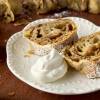These oversized scones, featured on Milk Street, are the creation of Briana Holt of Tandem Coffee + Bakery in Portland, Maine. Ginger in three different forms—ground, fresh and crystallized—give these breakfast pastries plenty of kick, as does black pepper.

Triple Ginger Scones with Chocolate Chunks
Start to finish: 1 hour 15 minutes (40 minutes active) | Makes 12 scones
INGREDIENTS:
- 455 grams (31⁄2 cups) all-purpose flour, plus more for dusting 67 grams (5 tablespoons) white sugar
- 4 teaspoons baking powder
- 1⁄2 teaspoon baking soda
- 2 tablespoons ground ginger
- 11⁄2 teaspoons grated nutmeg
- 21⁄2 teaspoons kosher salt
- 11⁄2 teaspoons ground black pepper 11⁄4 cups cold buttermilk
- 2 tablespoons finely grated fresh ginger
- 1 tablespoon grated orange zest
- 18 tablespoons (2 sticks plus 2 tablespoons) salted butter, cut into 1⁄2-inch pieces and chilled
- 150 grams (1 cup) roughly chopped bittersweet chocolate 154 grams (1 cup) finely chopped crystallized ginger
- 1 large egg, beaten
INSTRUCTIONS:
Heat the oven to 375°F with racks in the upper- and lower-middle positions. Line 2 rimmed baking sheets with kitchen parchment. In a large bowl, whisk together the flour, sugar, baking powder, baking soda, ground ginger, nutmeg, salt and pepper. In a 2-cup liquid measuring cup or a small bowl, stir together the buttermilk, grated ginger and orange zest.
To a food processor, add about 1⁄2 of the flour mixture and scatter the butter over the top. Pulse until the butter is in large pea-sized pieces, 10 to 12 pulses. Transfer to the bowl with the remaining flour mixture. Add the chocolate and crystallized ginger, then toss with your hands until evenly combined. Pour in about 1⁄3 of the buttermilk mixture and toss just a few times with your hands, making sure to scrape along the bottom of the bowl, until the liquid is absorbed. Add the remaining buttermilk in 2 more additions, tossing after each. After the final addition of buttermilk, toss until no dry, floury bits remain. The mixture will be quite crumbly and will not form a cohesive dough.
Lightly dust the counter with flour, turn the mixture out onto it, then give it a final toss. Divide it into 2 even piles, gathering each into a mound, then very briefly knead each mound; it's fine if the mixture is still somewhat crumbly. Gather each mound into a ball, then press firmly into a cohesive 5-inch disk about 11⁄2 inches thick. Brush the tops of each disk lightly with beaten egg. Using a chef's knife, cut each disk in half, then cut each half into 3 wedges. Place 6 wedges on each prepared baking sheet, spaced evenly apart.
Bake until the scones are deep golden brown, 27 to 30 minutes, switching and rotating the baking sheets halfway through. Cool on the baking sheets on wire racks for 5 minutes, then transfer directly to a rack and cool for at least another 5 minutes. Serve warm or at room temperature.
Notes: Don't worry if the flour-butter mixture doesn't form a cohesive dough immediately after all the buttermilk has been added. In fact, it will be very crumbly, but a brief kneading and the act of shaping and pressing the mixture into disks will bring it together. When kneading, though, take care not to overwork the dough, which will result in tough, not tender, scones.
Keep both the butter and buttermilk in the refrigerator until you're ready to use them so they stay as cold as possible, which makes the dough easier to handle. Holt recommends serving the scones after they've cooled to room temperature, but we also loved them warm, while the chocolate is soft and melty.
Visit 177MilkStreet.com for more information, and watch the episodes from past seasons here.




